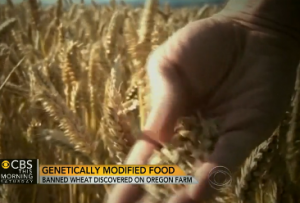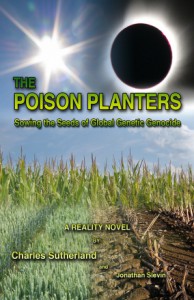GMO wheat used in field tests years ago was discovered earlier this year in an Oregon farmer’s field, raising questions over the source of the seed contamination as well as renewing concerns about “gene flow” (the natural transfer of genes among plant species including genes from genetically engineered, or transgenic, crops). This article, originally published in Acres USA, is posted here by author’s permission.

from CBS News video – |
Between 1856 and 1863 an Austrian monk, Gregor Mendel, cultivated and tested tens of thousands of plants, mostly peas, and described how traits are passed from parent to offspring. His discoveries are called “Mendel’s Law of Inheritance.” He is considered “the father of modern genetics.” Mendel, a botanist, would not have sanctioned altering crops chemically. Indeed, as a monk he probably would have regarded it as biological heresy to create genetic alterations in natural seeds for the purpose of increasing the sales of herbicides!
When, a century later, in 1970, the Monsanto chemist John Franz discovered that glyphosate could be used as a broad spectrum systemic herbicide to kill weeds, the reality was that it was also toxic to crops. So, Monsanto developed an Agrobacterium strain, creating an experimentally engineered gene called CP4, to be forcefully inserted into seeds for the purpose of resisting the toxic effects of glyphosate. Roundup became the best-selling herbicide in history—but people wondered, “What else do these seeds now contain?”
Although scientists originally discovered that DNA could be transferred between organisms in 1946, genetically modified crops were not introduced until the mid 1990s. By 1995 transgenic crops proliferating the market included corn, potatoes, soybeans, squash, cotton, and tomatoes…but not wheat. The marketing success of these new GMO crops led people to say GMO stands for “God Move Over”: Monsanto and other chemical companies were now producing food! It’s estimated that in 2013 approximately 85% of corn, 90% of soybeans, and 88% of cotton produced in the U.S. are genetically modified. But not wheat…
Then, this past April, the U.S. Department of Agriculture (USDA) reported that unapproved genetically modified wheat was located on an 80-acre field in Oregon. This not only shocked Oregon’s farmers, but also the state treasury and other wheat farmers, since Japan quickly suspended some wheat imports from the U.S. There is concern that Korea and others may follow, since most of Europe already bans GMO crops. According to U.S. Wheat Associates, about $8.1 billion of American wheat was exported in 2012. USDA figures show the value of Oregon’s 2011 wheat production was $503,031,000. Oregon, Idaho, and Washington export nearly 90% of their annual crop of soft white wheat. The economic repercussions of a boycott of U.S. wheat are staggering.

Soil and Crop Professor Carol Mallory-Smith, weed scientist at Oregon State University |
Although Monsanto’s genetically modified wheat was field tested from 1998 to 2005 in 16 states, including Oregon, for some reason Monsanto discontinued its nationwide wheat project before obtaining commercial approval. The last time Monsanto was allowed to test its genetically modified wheat in Oregon was in 2001, nearly 12 years ago. So, why suddenly does this wheat appear? Theories…and suspicions… are flying.
Many recall the allegations that Monsanto smuggled GMO seeds into Paraguay, disrupted the status quo of that agricultural community, and, through litigation and political pressure, eventually coerced the acceptance and continual expansion of its GMO crops. Similar allegations claim that Monsanto smuggled their Bt cotton into India and secretly fostered the dissemination of these seeds, resulting not only in the spread of their GMO products, but in continual suicides of farmers who cannot compete. In these, and other cases, Monsanto claims that someone stole their seeds and secretly planted them, only to be discovered by Monsanto’s ‘seed police.’ In each case, however, Monsanto ultimately benefited.
Suspicions abound. Cynics wonder once again if Monsanto clandestinely planted seeds in order to force the market open, while Monsanto claims once again that someone is sabotaging them. Adding to the obfuscation, Monsanto suggests there may have been ‘false positives’, and only they, Monsanto, are qualified to conduct valid tests. But, undeterred, Dr. Carol Mallory-Smith, weed science professor of Oregon State University, claims that sophisticated DNA tests specifically singled out the inserted gene. No matter. Once released into the environment genetic mistakes remain indefinitely, and commingling of crops is inevitable. Monsanto can never be exonerated.
Monsanto’s huge legal department is famous, or infamous, for initiating litigation against farmers and critics. Retaliation is on the horizon. Legal action has begun in Kansas and Washington, and farmers and government tax agencies around the country may now hold Monsanto responsible for “damages”—lost income or lost tax revenue. We’ll see…
THE POISON PLANTERS, a ‘reality novel’

|
By Charles Sutherland and Jonathan Slevin
The Poison Planters is a ‘reality novel’ of domestic and international intrigue in the battle against the powerful corporate giants which are spreading genetically modified organisms, GMO crops and rBGH milk, around the world.
It is a fact-filled international adventure, based on actual episodes of real people and companies.
The Poison Planters provides a warning concerning the global genetic genocide that is actively underway with the help of the U.S. government, various other national governments, and the United Nations.
[Read more]